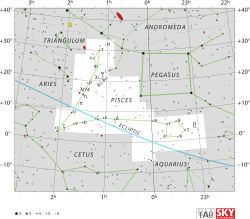Lambda Piscium

| |
| Observation data Epoch J2000.0 Equinox J2000.0 | |
|---|---|
| Constellation | Pisces |
| Right ascension | 23h 42m 02.8062s |
| Declination | +1° 46′ 48.147″ |
| Apparent magnitude (V) | 4.49 |
| Characteristics | |
| Spectral type | A7V[2] |
| U−B color index | +0.07 |
| B−V color index | +0.21 |
| Astrometry | |
| Radial velocity (Rv) | +12.4 km/s |
| Proper motion (μ) | RA: -129.55 mas/yr Dec.: -154.87 mas/yr |
| Parallax (π) | 32.38 ± 0.84 mas |
| Distance | 101 ± 3 ly (30.9 ± 0.8 pc) |
| Details | |
| Mass | 1.806[2] M☉ |
| Radius | 2.0403±0.0451[2] R☉ |
| Luminosity | 13.3897±0.1692[2] L☉ |
| Temperature | 7734±80[2] K |
| Age | 900[2] Myr |
| Other designations | |
Lambda Piscium (Lambda Psc, λ Piscium, λ Psc) is a star approximately 101 light years away from Earth in the constellation Pisces. It is a bluish-white star of A7V spectral classification, meaning it has a surface temperature of 7,500 to 11,000 kelvins. It is much brighter and hotter in surface temperature than the Sun, yet is approximately the same size.[3] Lambda Piscium forms the southeast corner of the "Circlet" in Pisces.[4]
Naming
In Chinese, 雲雨 (Yún Yǔ), meaning Cloud and Rain, refers to an asterism consisting of λ Piscium, κ Piscium, 12 Piscium and 21 Piscium. Consequently, λ Piscium itself is known as 雲雨四 (Yún Yǔ sì, English: the Fourth Star of Cloud and Rain.)[5]
References
- ↑ "Simbad Query Result". Simbad. Retrieved September 30, 2007.
- 1 2 3 4 5 6 Boyajian, Tabetha S.; et al. (July 2013), "Stellar Diameters and Temperatures. III. Main-sequence A, F, G, and K Stars: Additional High-precision Measurements and Empirical Relations", The Astrophysical Journal, 771 (1): 31, arXiv:1306.2974
 , Bibcode:2013ApJ...771...40B, doi:10.1088/0004-637X/771/1/40, 40. See Table 3.
, Bibcode:2013ApJ...771...40B, doi:10.1088/0004-637X/771/1/40, 40. See Table 3. - ↑ "Hipparcos Star Catalog Entry". Retrieved September 30, 2007.
- ↑ "Space.com - Meteor Watch, September 1-7, 2000". Retrieved September 30, 2007.
- ↑ (Chinese) AEEA (Activities of Exhibition and Education in Astronomy) 天文教育資訊網 2006 年 7 月 8 日
This article is issued from Wikipedia - version of the 10/25/2016. The text is available under the Creative Commons Attribution/Share Alike but additional terms may apply for the media files.